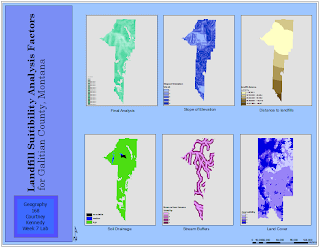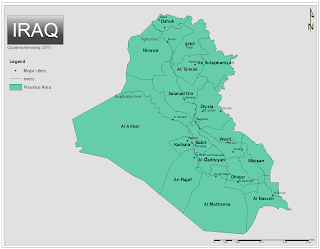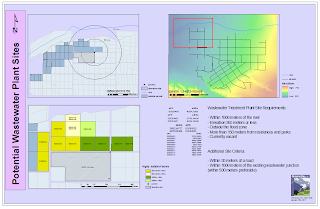
Introduction
Methods
In order to do the research for this project, I first located all the breweries in Portland city center through the use of various online resources, such as the Oregon Brewers Guild, and the Portland Online Beer Guide. I created an Excel file of all the reputable breweries, adding in their name as well as address. Then I was able to geocode these addresses on ArcGIS using the Street Map USA address locator. After adding the Portland street map from Street Maps USA, I plotted the geocoded addresses on the map. From here, I was able to do analysis work on the layer of breweries that I added to the map. For the housing information, I utilized various online real estate websites for Portland city area. I was able to compile a database on Excel of the homes for sale in Portland that were under $300,000. That way, it would be a more reasonable search, as well as the fact that trying to geocode every home for sale in Portland seemed like an unreasonable goal for the time allowed. With the Excel database, I was able to geocode all the $300,000 and under homes for sale and add them as a layer to the map, to later analyze.
For the crime rates, I used the Portland CrimeMapper website, from the Portland Police department. I was able to create a layer based on the different crime rates for the Portland city area. There were three classifications: low crime, medium crime, and high crime. These data were based on the crime rates of each area for the past 12 months. Using this information, I was able to analyze the homes for sale that I had geocoded to see where they were related in comparison to the medium and high crime areas, as well as how far they were in walking distance from breweries and pubs.
Results
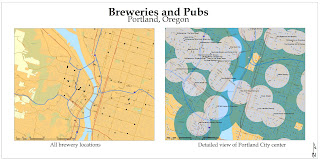
This first map above shows brewery locations in the Portland city center. If moving to Portland, this would be the place to live for beer. As it can be seen, there are a large amount of breweries and pubs in this area. The buffers around each brewery or pub shows how far it is logical to walk to each place. From this view, it is easy to see where the most breweries are located. They are centered on the west side of the Williamette river, which runs right through the middle of the Portland City area. So far, the area looks promising, there are lots of breweries as expected, so there should be plenty of homes for sale that are under $300,000.
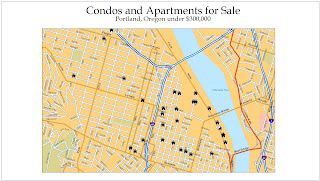 There are quite a few homes for sale in the Portland city area that are available under $300,000. However, which one to choose? Or, perhaps the home sells before I make an offer. Where should I look to find another perfect house? First of all, the home should be in a safe location. According to the Portland Crime Bureau, these are the crime rates in the area, based on the number of overall crimes in the last 12 months.
There are quite a few homes for sale in the Portland city area that are available under $300,000. However, which one to choose? Or, perhaps the home sells before I make an offer. Where should I look to find another perfect house? First of all, the home should be in a safe location. According to the Portland Crime Bureau, these are the crime rates in the area, based on the number of overall crimes in the last 12 months.This gives a good indication of neighborhoods, where, as a woman, I probably should avoid living in. Based on this information, I can eliminate some homes for sale. Using the "Select by Location tool", I chose the homes which were contained by the "High Crime Rate" and "Medium Crime Rate" zones. The "Low Crime Rate" was pervasive throughout the city, and could not be avoided. I also compared the homes and their distance from the breweries and pubs in the city center. Luckily, all the homes under $300,000 were within the limit of 1/2 mile from any brewery or pub. None were eliminated because of this, but there were certainly some homes that were closer than others to many breweries.
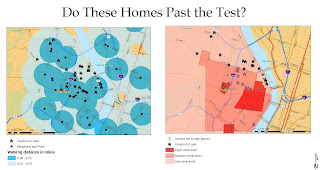
Based on this information, some homes were eliminated because they were in areas with more crimes than acceptable.
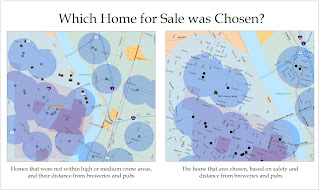 Lastly, in the above map, there are the results of the combination of all factors that were analyzed in the process. The homes in the right hand map, closest to the river, were eliminated based on the fact that they were very close to a high crime area, versus the other homes away from the river, which were not near a high crime zone, yet still within the buffer of breweries and pubs. Preference was given to the homes for sale that were in the darker blue buffer area of breweries and pubs, which meant that they were only a quarter mile away, a very walkable distance. After all this analysis, I chose the home at 2080 Overton Street as the best place. It is located within the quarter mile buffer from A few breweries, as well as the half mile buffer of many other breweries as well. Additionally, there is not need to enter into any areas of high crime while walking home.
Lastly, in the above map, there are the results of the combination of all factors that were analyzed in the process. The homes in the right hand map, closest to the river, were eliminated based on the fact that they were very close to a high crime area, versus the other homes away from the river, which were not near a high crime zone, yet still within the buffer of breweries and pubs. Preference was given to the homes for sale that were in the darker blue buffer area of breweries and pubs, which meant that they were only a quarter mile away, a very walkable distance. After all this analysis, I chose the home at 2080 Overton Street as the best place. It is located within the quarter mile buffer from A few breweries, as well as the half mile buffer of many other breweries as well. Additionally, there is not need to enter into any areas of high crime while walking home. Conclusion
Through the use of ArcGIS and the analysis of geocoded point and areas, I was able to find the perfect place to live in Portland to have the best access to good beer in the United States. Additionally, since I am probably not moving to Portland right away, the home that I found for sale will most likely have been sold by the time I get there. However, after completing this assignment, I am much more familiar with the Portland area, and thus using the information acquired in this exercise, I will be able to easily asses other homes for sale based on their location. Also, the map could serve as a guide for other people moving to Portland, who also would like to be close to nightlife, breweries, but also would like to stay out of the areas with high crime rates. Thus, this map can be helpful to all kinds of people who have an interest in moving to this unique area. A more lofty project goal, of course, could also be to include all the best restaurants in Portland, since I do love food as well. Additionally, since I love cooking, it could be useful to add in good organic farmers markets, as well as specialty food shops. This way, the guide would be more comprehensive in all aspects. However, I felt that this was a good way to get to know the various areas of Portland, even though I have never been there. Overall, I found that my experience gained in this class was extremely useful, and I hope that I will be able to use all I learned about GIS in the future.








